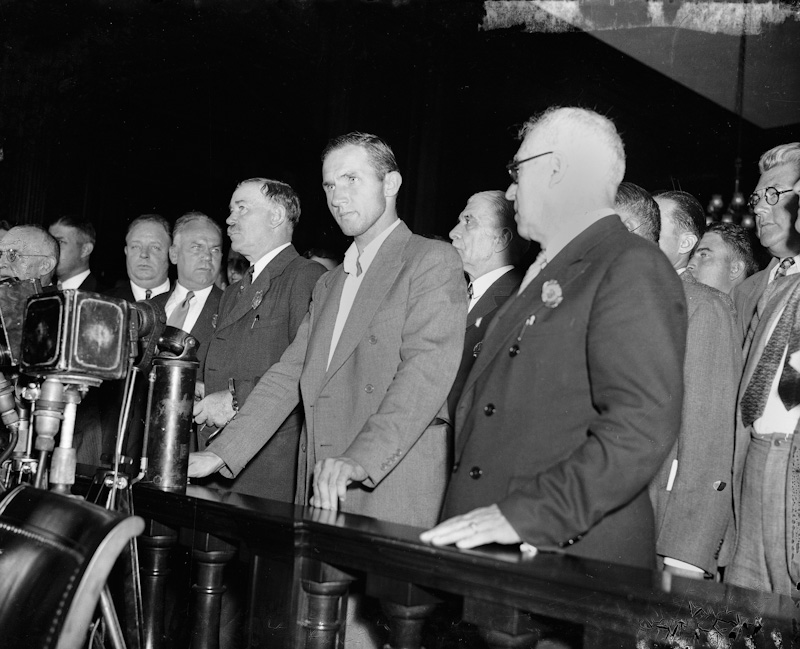Was wrong person executed in death of Lindbergh baby? Ex-judge's book and DNA quest raise issues

German immigrant Bruno Richard Hauptmann (center) pleads not guilty in the Bronx County Court in New York on Sept. 27, 1934, to extorting $50,000 from aviator Charles A. Lindbergh for the return of Lindbergh’s kidnapped son. (Photo from the Associated Press)
Updated: A court case and a book by a former judge are raising questions about the guilt of German immigrant Bruno Richard Hauptmann, a man convicted and executed in the 1932 kidnapping and death of the 20-month-old son of aviator Charles A. Lindbergh.
Lawyer Kurt Perhach is asking a New Jersey appeals court to reverse a judge’s 2023 ruling that rejected his client’s bid to test saliva on stamped ransom envelopes to determine whether Hauptmann is the killer, report the New York Times, the San Francisco Chronicle and New Jersey Monthly.
The judge had reasoned that the state’s open-records law “is not the vehicle by which a citizen can march up to a museum and demand that the custodians of historical artifacts and documents surrender the state’s treasures for analysis, alteration and destruction.”
Hauptmann’s great-great niece and her aunt have provided DNA samples that could help answer the question whether their late relative is indeed guilty.
A retired California judge, Judge Lise Pearlman, is not part of that lawsuit, but she is promoting a theory that Lindbergh is a potential suspect. She says that Lindbergh was fascinated with eugenics and had been conducting research with Dr. Alexis Carrel, a surgeon and an organ transplant pioneer.
“My theory is that the child was operated on,” Pearlman told the San Francisco Chronicle. “We think at the very least that his carotid and probably his thyroid were taken out and kept viable for 30 days. We think he died on the operating table. And I think Carrel conducted the operation with Lindbergh’s permission—and Lindbergh was likely present at the operation.”
She suggests that Carrel had operated on the toddler and removed organs to see whether they could be preserved outside the body for use in transplants. The goal may have been to help Lindbergh’s sister-in-law, who had a damaged heart valve.
An autopsy of the toddler had revealed that all his organs were missing, except for his heart and liver, according to the New York Times. And there appeared to be no blood in the woods where the body was found. Investigators had attributed the missing organs to animals feeding on the body.
Pearlman points to other clues—there appeared to be no vermin on the body, and the toddler’s face and feet may have decomposed more slowly than the rest of the body. That could mean that chemicals had been used.
Hauptmann was arrested in 1934 after he used a $10 gold certificate that was part of a ransom payment to buy gas. Hauptmann had claimed, however, that a man had asked him to hold the gold certificates before he died in Germany.
Some dispute Pearlman’s theories, including David M. Friedman, who wrote The Immortalists: Charles Lindbergh, Dr. Alexis Carrel, and Their Daring Quest to Live Forever. He called Pearlman’s ideas “malicious garbage” in an interview with the New York Times. He acknowledged, however, that he had not read Pearlman’s book.
Updated March 12 at 9:10 a.m. to report that David M. Friedman said he had not read Judge Lise Pearlman’s book.
Write a letter to the editor, share a story tip or update, or report an error.



